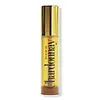What's inside
What's inside
 Key Ingredients
Key Ingredients

 Benefits
Benefits

 Concerns
Concerns

 Ingredients Side-by-side
Ingredients Side-by-side

Butyl Methoxydibenzoylmethane 2.9%
UV AbsorberHomosalate 5%
Skin ConditioningEthylhexyl Salicylate 4.9%
UV AbsorberOctocrylene 8%
UV AbsorberButyloctyl Salicylate
Skin ConditioningButyrospermum Parkii Butter Unsaponifiables
Skin ConditioningCaprylic/Capric Triglyceride
MaskingCapryloyl Glycerin/Sebacic Acid Copolymer
Skin ConditioningCetearyl Ethylhexanoate
EmollientEthyl Ferulate
AntioxidantAroma
Glyceryl Behenate
EmollientHdi/Trimethylol Hexyllactone Crosspolymer
Hydrogenated Poly(C6-20 Olefin)
AbrasiveHydrolyzed Sodium Hyaluronate
Skin ConditioningLimnanthes Alba Seed Oil
Skin ConditioningPalmitoyl Tripeptide-38
Skin ConditioningPolyester-8
Skin ConditioningPolyglyceryl-2 Isostearate/Dimer Dilinoleate Copolymer
EmollientPortulaca Pilosa Extract
Skin ConditioningPrunus Avium Seed Oil
EmollientSilica Silylate
EmollientSorbitan Isostearate
EmulsifyingSoybean Glycerides
EmollientStevia Rebaudiana Extract
Sucrose Cocoate
EmulsifyingTetrahexyldecyl Ascorbate
AntioxidantTocopherol
AntioxidantTrimethylpentanediol/Adipic Acid/Glycerin Crosspolymer
Skin ConditioningVitis Vinifera Seed Oil
EmollientButyl Methoxydibenzoylmethane 2.9%, Homosalate 5%, Ethylhexyl Salicylate 4.9%, Octocrylene 8%, Butyloctyl Salicylate, Butyrospermum Parkii Butter Unsaponifiables, Caprylic/Capric Triglyceride, Capryloyl Glycerin/Sebacic Acid Copolymer, Cetearyl Ethylhexanoate, Ethyl Ferulate, Aroma, Glyceryl Behenate, Hdi/Trimethylol Hexyllactone Crosspolymer, Hydrogenated Poly(C6-20 Olefin), Hydrolyzed Sodium Hyaluronate, Limnanthes Alba Seed Oil, Palmitoyl Tripeptide-38, Polyester-8, Polyglyceryl-2 Isostearate/Dimer Dilinoleate Copolymer, Portulaca Pilosa Extract, Prunus Avium Seed Oil, Silica Silylate, Sorbitan Isostearate, Soybean Glycerides, Stevia Rebaudiana Extract, Sucrose Cocoate, Tetrahexyldecyl Ascorbate, Tocopherol, Trimethylpentanediol/Adipic Acid/Glycerin Crosspolymer, Vitis Vinifera Seed Oil
Octocrylene 9%
UV AbsorberEthylhexyl Salicylate 5%
UV AbsorberHomosalate 4.5%
Skin ConditioningButyl Methoxydibenzoylmethane 3%
UV AbsorberBenzyl Alcohol
PerfumingButylene/Ethylene/Styrene Copolymer
C12-15 Alkyl Benzoate
AntimicrobialEthylene/Propylene/Styrene Copolymer
Ethylhexyl Olivate
Skin ConditioningAroma
Glyceryl Caprylate
EmollientGlyceryl Undecylenate
EmollientIsohexadecane
EmollientPersea Gratissima Oil
Skin ConditioningPolyamide-3
Polybutene
Silica Cetyl Silylate
Simmondsia Chinensis Seed Oil
EmollientSodium Hyaluronate
HumectantStevia Rebaudiana Leaf Extract
EmollientTocopheryl Acetate
AntioxidantTripeptide-1
Skin ConditioningXanthan Gum
EmulsifyingOctocrylene 9%, Ethylhexyl Salicylate 5%, Homosalate 4.5%, Butyl Methoxydibenzoylmethane 3%, Benzyl Alcohol, Butylene/Ethylene/Styrene Copolymer, C12-15 Alkyl Benzoate, Ethylene/Propylene/Styrene Copolymer, Ethylhexyl Olivate, Aroma, Glyceryl Caprylate, Glyceryl Undecylenate, Isohexadecane, Persea Gratissima Oil, Polyamide-3, Polybutene, Silica Cetyl Silylate, Simmondsia Chinensis Seed Oil, Sodium Hyaluronate, Stevia Rebaudiana Leaf Extract, Tocopheryl Acetate, Tripeptide-1, Xanthan Gum
 Reviews
Reviews

Ingredients Explained
These ingredients are found in both products.
Ingredients higher up in an ingredient list are typically present in a larger amount.
Aroma refers to an ingredient, or mixture of ingredients, that impart or mask a flavor.
The name is slightly confusing. This is because INCI associates aroma with flavor instead of smell.
Here is the official definition from the The International Cosmetic Ingredient Dictionary and Handbook:
“Aroma is a term for ingredient labeling used to identify that a product contains a material or combination of materials normally added to a cosmetic to produce or to mask a particular flavor.”
INCI shows the only purpose of aroma to be "flavouring".
However, due to regulation differences, some companies may use aroma in place of parfum.
In Canada, this ingredient only has to be listed in concentrations above 1%.
Learn more about AromaAlso known as Avobenzone, this ingredient is a chemical sunscreen filter that provides protection in the UV-A range.
Avobenzone is globally approved and is the most commonly used UV-A filter in the world.
Studies have found that avobenzone becomes ineffective when exposed to UV light (it is not photostable; meaning that it breaks down in sunlight). Because of this, formulations that include avobenzone will usually contain stabilizers such as octocrylene.
However, some modern formulations (looking at you, EU!) are able to stabilize avobenzone by coating the molecules.
Avobenzone does not protect against the UV-B range, so it's important to check that the sunscreen you're using contains other UV filters that do!
The highest concentration of avobenzone permitted is 3% in the US, and 5% in the EU.
Learn more about Butyl MethoxydibenzoylmethaneEthylhexyl Salicylate is an organic compound used to block UV rays. It primarily absorbs UVB rays but offers a small amount of UVA protection as well.
Commonly found in sunscreens, Ethylhexyl Salicylate is created from salicylic acid and 2-ethylhexanol. You might know salicylic acid as the effective acne fighter ingredient and BHA.
The ethylhexanol in this ingredient is a fatty alcohol and helps hydrate your skin, similar to oils. It is an emollient, which means it traps moisture into the skin.
According to manufacturers, Ethylhexyl Salicylate absorbs UV wavelength of 295-315 nm, with a peak absorption at 307-310 nm. UVA rays are linked to long term skin damage, such as hyperpigmentation. UVB rays emit more energy and are capable of damaging our DNA. UVB rays cause sunburn.
Learn more about Ethylhexyl SalicylateHomosalate is a chemical sunscreen filter that provides protection in the UV-B range (280nm - 320 nm), with a peak protection at 306 nm. It is internationally approved for use in sunscreens.
Homosalate is not photo-stable, meaning it's strength as a UV filter degrades over time with exposure to the sun. Because of this, it's often used in combination with other chemical sunscreen filters as avobenzone (which protects from the UV-A range). Homosalate also helps act as a solvent for harder-to-dissolve UV filters.
(Part of the reason that sunscreens need to be frequently re-applied is due to the photo instability of many chemical sunscreen filters)
Currently, homosalate is approved in concentrations up to 10% in the EU and 15% in the US. The FDA is currently doing further research on the effects of homosalate, and it is possible that these approved concentrations will change in the future.
Learn more about HomosalateOctocrylene protects skin from sun damage. It absorbs UV-B with peak absorption of 304 nm. It is a common sunscreen ingredient and often paired with avobenzone, a UVA filter. This is because octocrylene stabilizes other sunscreen ingredients by protecting them from degradation when exposed to sunlight. Octocrylene is a photostable ingredient and loses about 10% of SPF in 95 minutes.
Octocrylene also acts as an emollient, meaning it helps skin retain moisture and softens skin. It is oil-soluble and hydrophobic, enhancing water-resistant properties in a product.
Those who are using ketoprofen, a topical anti-inflammatory drug, may experience an allergic reaction when using octocrylene. It is best to speak with a healthcare professional about using sunscreens with octocrylene.
The EU allows a maximum of these concentrations:
Learn more about Octocrylene